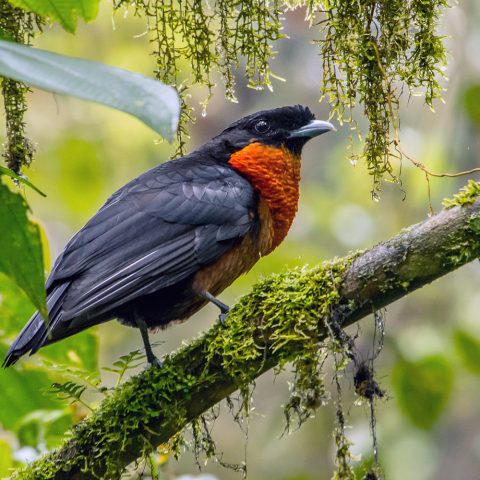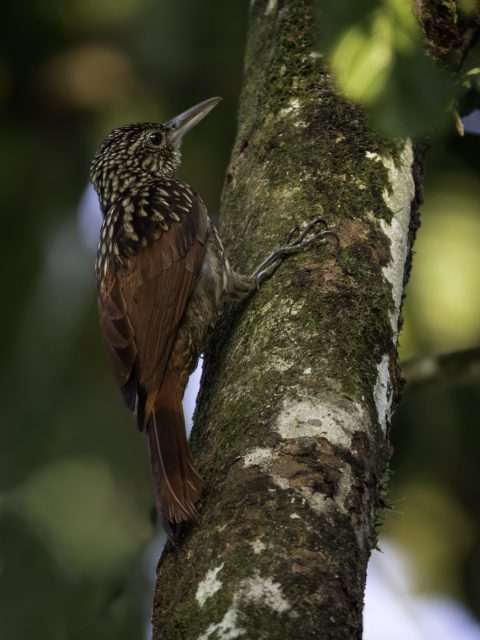The orange-breasted fruiteater (Pipreola jucunda) is a species of bird in the family Cotingidae native to Colombia and Ecuador. Its natural habitat is subtropical or tropical moist montane forests. It is a plump green bird about 18 centimetres (7 in) long. Males have a glossy black head and bib, an orange throat and yellow belly. Females lack the dark head and have green upper parts and green and yellow streaked underparts. Both sexes have orange beaks and greyish-green legs. This is a relatively common species with a wide range, and the International Union for the Conservation of Nature has rated its conservation status as being of «least concern».

This hummingbird is an inhabitant of humid forests on the eastern slope of the Eastern Cordillera and the Serranía del Perijá, less known in the Western and Central Cordilleras. Its name Campylopterus means curved wings and derives from the Greek roots kampulos = curved and pteron = wing.
The Red-ruffed fruitcrow is a species of passerine bird, the only one of the monotypic genus Pyroderus, of the Cotingidae family. It is native to South America.
This bird is around 23cm. It has unmistakable characteristics. Above its beak it is black and below it is orange. Its eyes are red and it has a rather long tail. It is deep black in color with white cheeks, white pectoral tufts and broad white tips on its outer rectrices. It has inner margins of white inner rectrices that are prominent in flight.
It´s a species of bird placed in the family Grallariidae, previously included in Formicariidae. It is native to the Andean region of northwestern South America.
Own of Central America and the extreme northwest of South America. This Nuthatch is the only one with densely ridged tops and bottoms. Its name Xiphorhynchus comes from the Greek roots xiphos = sword and rhunkhos = beak. The epithet lachrymosus comes from Latin and means full of tears.
The giant hummingbird (Patagona gigas) is the only member of the genus Patagona and the largest member of the hummingbird family, weighing 18–24 g (0.63–0.85 oz) and having a wingspan of approximately 21.5 cm (8.5 in) and length of 23 cm (9.1 in). This is approximately the same length as a European starling or a northern cardinal, though the giant hummingbird is considerably lighter because it has a slender build and long bill, making the body a smaller proportion of the total length. This weight is almost twice that of the next heaviest hummingbird species, and ten times that of the smallest, the bee hummingbird.
The Long-tailed Tyrant (Colonia colonus) is a species of passerine bird of the Tyrannidae family that lives in South and Central America. It is the only member of the genus Colonia.
This species is quite gregarious and noisy and is found in the western lowlands of the country. Its name Mitrospingus means crown finch, referring to the coloration of the latter and derives from the Greek roots mitra = crown or hood and spingos = finch. His epithet cassinii was established in honor of the North American ornithologist John Cassin.
This species is found in the lowlands in the north of the country and east of the Andes. It is a fairly silent bird and is difficult to confuse with other jumpers. Its name Saltator derives from Latin and means dancer while its epithet Orenocensis refers to the Orinoco River.












